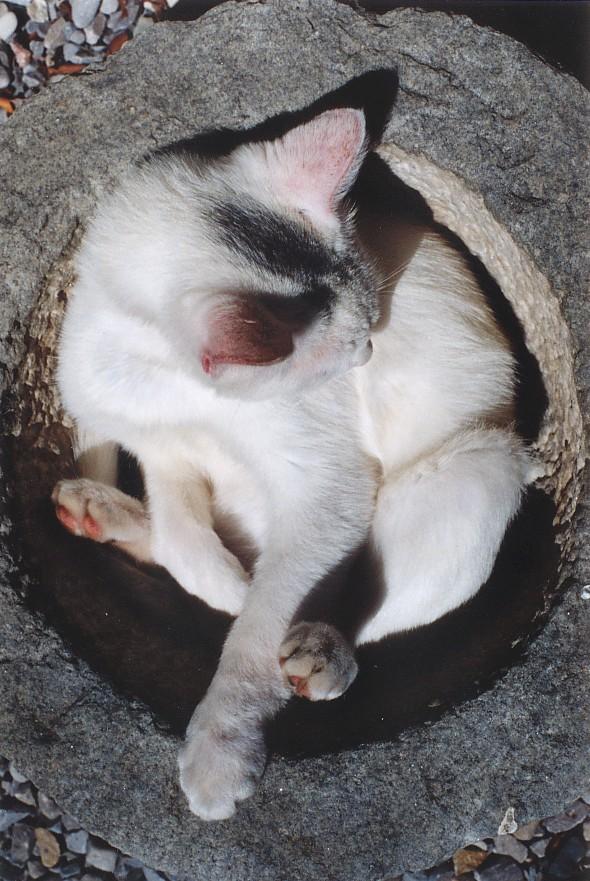The Trough
As temperatures plunge and light fails in October, we move a great assortment of potted plants from the outdoor frames into the greenhouse. They are mostly stock plants from which we take a lot of our winter cuttings. Others are rare or sensitive plants - some in pots, some in stone troughs - that aren't yet put to the ultimate trial of "open garden" planting. Having grown accustomed to container growing, we have come to enjoy using these troughs as an intermediate (and portable) growing environment. Of course, container culture can still be challenging for several reasons:
- Roots are physically restricted, especially for chasmophytic species, which prefer to amble into many crevices.
- Soil chemistry can present problems due to salt build-up either from the fertilizer or the irrigation water.
- Gradual compaction of soil over time will reduce the amount of oxygen available to the roots.
- Repeated drying and subsequent re-watering reduce the "wetting" ability of the soil, until the water is actually repelled and passes straight through without being absorbed.
Soil
Consequently, container plants require a soil that:
- has adequate porosity to allow air and water retention; somewhere in the range of 80% of volume.
- is relatively stable and doesn't compact or break down.
- is lightweight and inexpensive.
Most commercial mixes contain varying amounts of mineral material (perlite, turface or grit) added to an organic base of peat or bark. Typically, these mixes have 50% or more water retention and 20-30% air space for a total porosity of ~80%. They can become waterlogged quite easily and need careful watering. With time, most organic mixes will decompose and compress becoming less suitable for root growth. Lower porosity means less oxygen and more problems with root diseases and crown rot. We prefer to make our own mixes and take into account the plant's particular needs regarding:
- Porosity, especially air content.
- Soil chemistry: specifically, mineral nutrients.
Like many nurseries, our mix for the relatively easy plants is based on composted pine bark with the addition of perlite or pumice grit. Pine bark is widely used as it helps prevent crown rot; fir bark is even better. Heavy feeders (gentians, primulas) do well in this mix.
Variations
When it comes to growing more sensitive plants, mixes and methods deviate from the norm. Usually this means a base that is more open and faster draining to reduce the conditions favoring disease. Consider the following 3 examples:
The mix for dicentra peregrina and epilobium rigidum is basically pumice grit with a bit of turface or perlite - no organic is used. Both plants can tolerate short periods of dryness but will grow continuously if moisture is kept at an optimum level. This balance is not difficult to manage, but cannot be accomplished with the average garden centre watering regimen. With a bit of knowledge, most gardeners can effect better control than a large commercial operation.
Penstemon acaulis grows in rather heavy, silty soils that are rich enough to grow wheat if water is supplied. In our wetter climate of Southern Ontario, it grows best in a deep, calcareous gravel; or better yet in tufa gravel. Either way, it will tolerate considerable water when in active growth until just after blooming, about the first of July, when water should be restricted. In containers, tufa crumb with no organic matter works very well.
In some cases (eg. kabschia saxifraga) we plant rooted cuttings directly in a piece of drilled tufa. Sifted tufa grit, instead of soil, is placed around the roots. The most dramatic effect is seen in saxes as they grow much more in character, never failing to attract the attention of even the most casually interested. In tufa, plants must send a multitude of small feeder roots through the labyrinthine matrix that composes the stone. Most interesting is the porosity of tufa; ~60% of volume is open space, of which 2/3 is air space and about 1/3 retained water (after a thorough soaking). It is virtually impossible to waterlog unless it is left in standing water. The water, oxygen and nutrient supply to the feeder roots is superb. Light liquid feeding is very effective. By extension, a mix of tufa and pumice grits provides a very well aerated and buffered "soil" to grow in, either alone, or in combination with some composted bark.

Summary
OK, so what does this mean for trough growing? Well, a lot depends on what is being grown. Consider first a trough with plants growing in pieces of tufa. The surrounding medium is somewhat less important and is basically acting as physical support and as a moisture reservoir for the tufa. For this supporting medium, any free-draining materials, ranging from composted bark to coarse sand will work. Tufa gravel, with or without some compost, is the best material as it provides a better visual tie between the stones. For plants growing freely in a container, rather than in a tufa block, a mix of tufa and/or pumice with some organic content (this can vary) provides a free-draining, well-aerated soil. Generally speaking, to increase water-holding ability, as might be needed in a drier climate, add more organic matter. The amount used depends on climate.
Lastly, there is one caveat that has stood the test of time: Use rainwater for your container water needs. It is the one thing, no matter where you live, that will measurably improve the health of your plants. What worked for your grandmother will work for you
.
Source Information
The April, 1987 issue of the ORGS Journal contains a definitive article on the physical characteristics of common materials used for soil mixes. The author, Barrie Porteous, clearly describes a number of different materials in terms of key physical properties, including porosity, air and water retention.
(2004 Catalogue Introduction)

Comments (0)
Add new comment